Crotch Patch For Jeans: Strong And Easy Fixes For Ripped Denim
A ripped jean crotch is a common and frustrating problem. That dreaded tear in the inner thigh or a “crotch blowout” can make you think your favorite denim is done for. But don’t worry, it’s usually a fixable issue.
This article will provide easy-to-understand instructions on how to patch the crotch of ripped jeans. We’ll cover different methods for denim repair, so you can choose the one that best suits your skills and the damage. Learning to fix ripped jeans not only saves money but also extends the life of your clothes.
1. Why jean crotches tear and a few quick prevention ideas
Jean crotches often tear due to a few common reasons. Constant friction from walking and movement puts stress on the fabric and seams in that area. Over time, this wear can lead to holes as the fabric simply thins out.
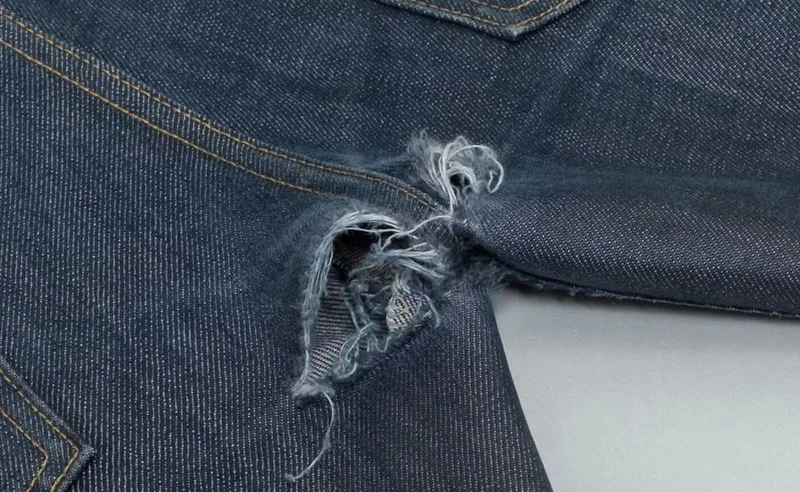
Here are a few simple tips to help prevent jean tears:
- Ensure your jeans fit properly. If they are too tight, especially in the thigh and crotch area, they are more likely to rip.
- Avoid putting too much stress on the area. If your jeans are already feeling thin, be mindful during activities that stretch the fabric.
- For jeans you love and wear often, consider early reinforcement on the inside if you know this is a common issue for you.
2. Tools and materials for your jean crotch repair
Before you start your denim mending, gathering the right tools and materials will make the process much smoother.
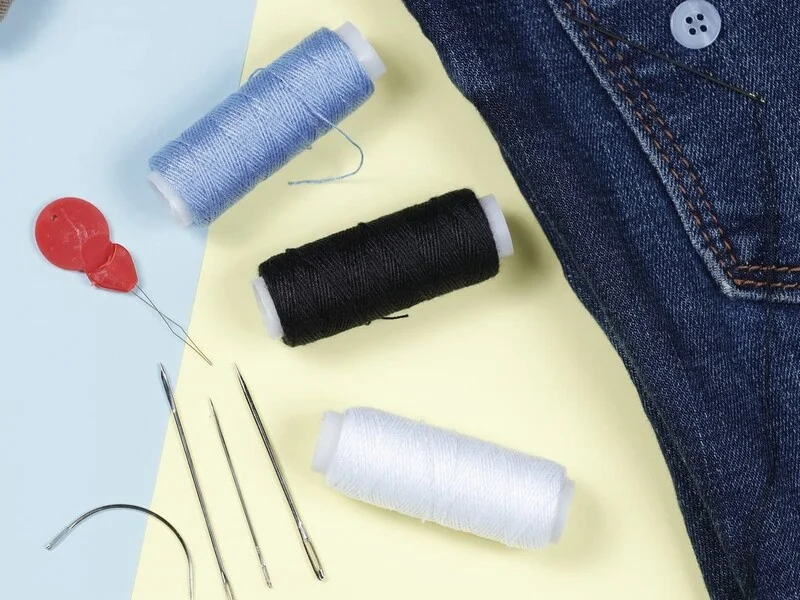
2.1. Essential toolkit
Here are the basic tools you’ll need:
- Needle: A denim needle is best because it’s strong enough for thick fabric. A sturdy universal needle can also work.
- Strong thread: Polyester thread for jeans or specific denim thread is recommended. Try to match the thread color to your jeans for a less visible repair.
- Sharp fabric scissors: Good fabric scissors ensure clean cuts and prevent further fraying.
- Straight pins: These are essential for holding your patch in place while you work.
- Iron and ironing board: These are crucial if you’re using an iron-on patch and helpful for pressing seams flat when hand-sewing.
2.2. Choosing your patch material
The choice of patch material is important for a lasting repair.
- Scrap denim: This is often the best choice. Using denim from an old pair of jeans will likely match the color, weight, and texture of the jeans you’re repairing.
- Store-bought denim patches: These are widely available and come in various shades. Many are iron-on for convenience.
- Other strong fabric: If you don’t have scrap denim, a heavy-duty cotton twill or sturdy canvas can work.
Consider the weight and color of your patch material. It should be similar to your jeans for the best result.
2.3. Prepping the damaged area
Properly preparing your jeans is an important first step.
- Trim: Carefully trim any loose threads around the hole in the jeans crotch.
- Clean and flat: Make sure the area is clean and lay the jeans flat on your work surface.
- Patch placement: Decide if you’ll patch from the inside or outside. For crotch repairs, patching from the inside usually gives a neater, less visible finish.
3. Method 1: The classic hand-sewn inside patch
This sewing method creates a durable and discreet repair. It’s an excellent method for creating a durable reinforcement by hand.
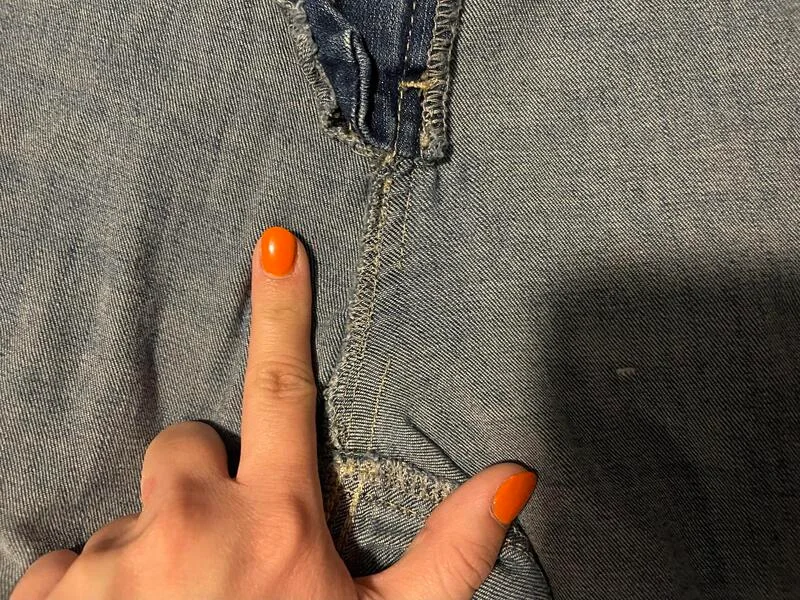
3.1. Why choose this method
This method creates a very durable repair that is one of the least visible from the outside when done carefully. It offers a neat finish and results in one of the strongest patches, especially when using a backstitch.
3.2. Step-by-step instructions
Here’s how to do it:
- Cut your patch: Make the patch at least 1/2 inch (1-2 cm) larger than the hole on all sides. Round the corners of the patch to help prevent the edges from lifting later.
- Prepare your jeans: Turn your jeans inside out.
- Position the patch: Place your denim patch over the hole on the inside of the jeans and pin it securely with straight pins.
- Thread your needle: Use a strong thread. Doubling the thread can add extra strength. Tie a secure knot at the end.
- Sew the patch: Start sewing from the inside. A backstitch is very secure, but a small, tight running stitch can also work. For extra strength, you can use a simple darning stitch to secure the frayed edges of the original hole to the patch.
- Secure the edges: Sew all around the edges of the patch. Add another round of stitching around the original hole’s edges, attaching them firmly to the patch underneath.
- Finish: Knot the thread securely on the inside of the jeans and trim any excess thread.
4. Method 2: The quick iron-on patch
If you’re looking for a fast solution, an iron-on patch is a popular choice. This method is a quick, easy, and no-sew option, making it a great choice for beginners.
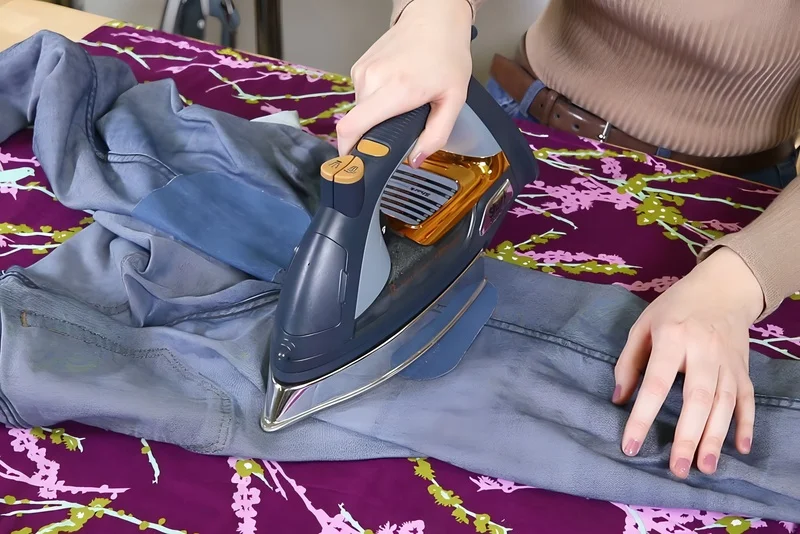
4.1. Why this method is popular
This method is quick, easy, and requires no initial sewing, making it a good choice for beginners looking for a simple jean patch solution.
4.2. Step-by-step instructions
Here’s how to apply an iron-on patch correctly:
- Choose your patch: Select an iron-on denim patch that closely matches your jean’s color and texture.
- Prepare jeans: Trim any loose threads from the hole. The area must be clean and completely dry. Turn the jeans inside out, which is usually best for crotch repairs.
- Position patch: Place the patch with the adhesive side down, covering the hole.
- Protect fabric: Cover the patch and the surrounding area with a thin cotton cloth, like a tea towel, to prevent scorching.
- Iron: Press firmly with a hot, dry iron. Check the patch instructions for the correct temperature, typically the cotton setting with no steam. Hold the iron still and press down for the recommended time, often 30-60 seconds.
- Cool down: Let the area cool completely. Check the edges of the patch. If any part is loose, re-iron that spot for a few more seconds.
4.3. An important note on durability
The crotch area of jeans experiences a lot of stress and movement. For an iron-on patch repair to last, we strongly recommend adding stitches. After the patch has cooled, hand-sew or machine-sew around its edges. This step significantly improves the patch’s durability, ensuring the repair will last.
5. Method 3: Machine sewing for an extra-tough fix
For larger holes or when you need maximum strength, machine sewing is an excellent method.
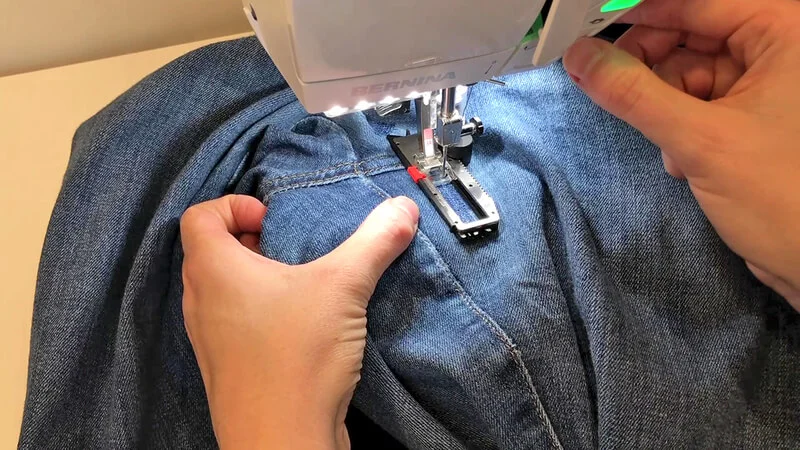
5.1. When to choose this method
Choose this method if you have a larger hole, the area needs maximum durability, and you are comfortable using a sewing machine. It is often the best way to fix a large rip in jeans.
5.2. Basic steps for machine sewing
You’ll need basic sewing machine skills for this method.
- Prepare patch and jeans: Cut a denim patch that is larger than the hole and trim loose threads from the tear.
- Machine setup: Use a denim needle in your sewing machine with strong thread.
- Stitch selection: A zig-zag stitch is excellent as it covers edges well and allows for flexibility. Alternatively, a short straight stitch can be used.
- Position patch: Place the patch on the fabric, usually on the inside for crotch repairs, and pin it in place.
- Sew: Sew around the edges of the patch. Then, sew over the damaged area by sewing straight lines close together or using a zig-zag pattern. This attaches the torn fabric securely to the patch.
- Secure stitches: Backstitch at the beginning and end of your sewing to lock the stitches.
6. Pro tips for a lasting and good-looking repair
Here are some extra tips to improve the durability and appearance of your jeans repair, helping to extend the garment’s life.
- Use a patch material and thread color that closely match your jeans for a less visible mend.
- Patching from the inside usually looks neater for crotch repairs.
- For very frayed holes, consider doing some light darning stitch work on the original fabric first to stabilize it before you apply the main patch.
- Avoid stretching the jean fabric while sewing or ironing, as this can cause puckering.
- Always round the corners of your patches to help prevent them from lifting or fraying.
- Wash your repaired jeans inside out using cooler water to help the patch last longer.
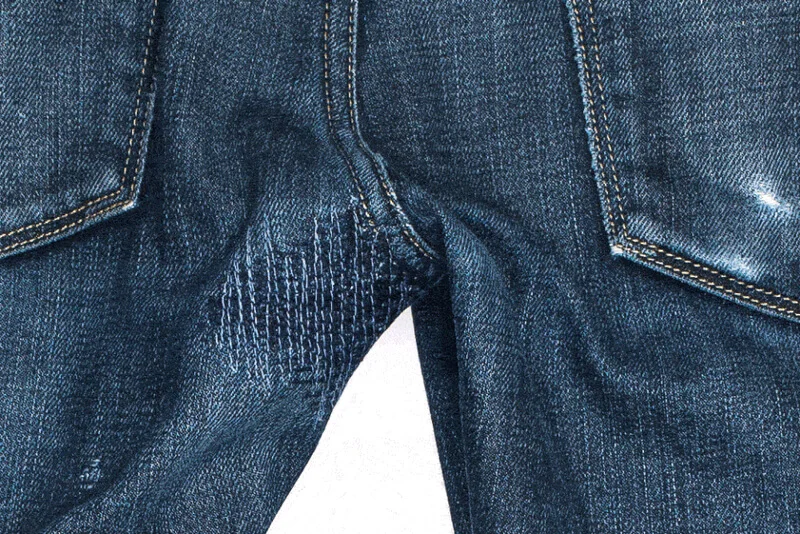
7. Beyond the basic fix: Adding style with Packlove
You’ve successfully fixed the hole, but what if you want to make the mend a design feature? This is where custom patches and decorative mending can turn a simple repair into a style statement. While a basic patch fixes the problem, Packlove products can help you achieve a more personalized look.
It’s important to remember: Packlove products are best used for style enhancement or light reinforcement after the main structural repair is complete.
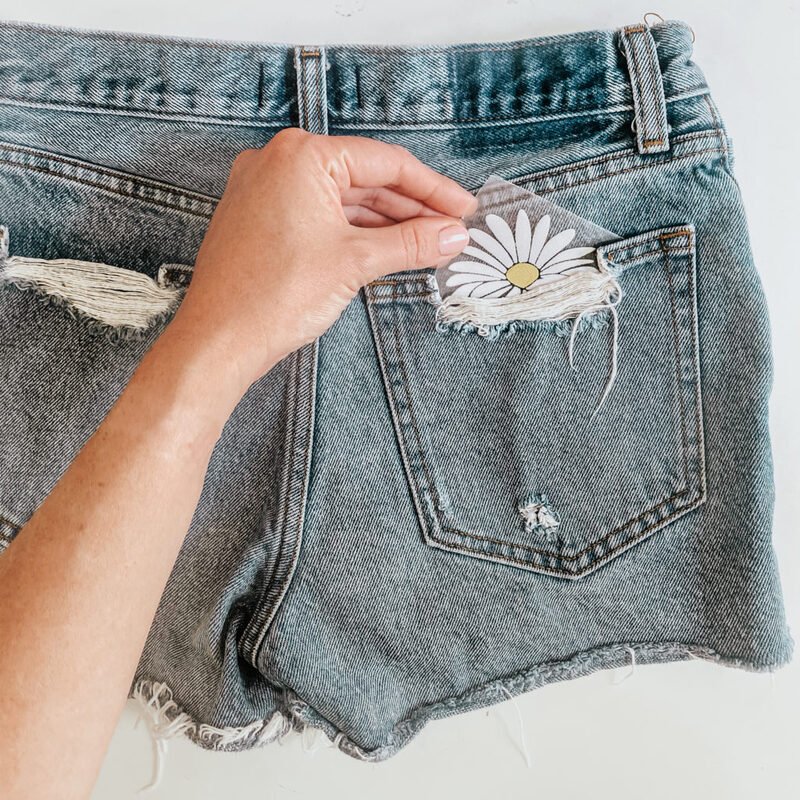
7.1. Using Packlove products to elevate your repair
- Heat transfer labels: These are thin, flexible, iron-on designs perfect for adding custom details. After your main patch is secure, you can apply a heat transfer label to the outside to cover the mended area with a cool design, turning the repair into a style feature.
- Rubber labels/patches: These are strong, flexible, and tactile patches. Sew these onto the outside of the repaired area for a modern, tough look. They can even add a light reinforcing effect.
7.2. Key considerations for using Packlove enhancements
For the best results, remember that the structural repair must come first. Decorative elements like those from Packlove are designed for style and enhancement; they are not intended to be the primary fix for a significant tear. Think of them as the finishing touch that turns your functional repair into a deliberate design choice.
8. Frequently asked questions (FAQs)
Here are answers to common questions about mending a tear in the crotch of your jeans.
8.1. What’s the absolute strongest thread for repairing jeans?
Polyester denim thread or a good quality heavy-duty polyester thread is usually the strongest choice.
8.2. Can I really fix my jeans crotch without any sewing?
No-sew methods like high-quality iron-on patches can work for very small tears or as a temporary fix. However, for the high-stress crotch area, adding stitches to an iron-on patch is highly recommended for durability.
8.3. How do I stop my jeans from ripping in the crotch again?
You can reinforce jeans to prevent tears by adding an internal patch to new jeans before they rip. Also, ensure your jeans fit well and are not too tight.
8.4. What if the hole is really big?
A large, strong denim patch is needed. Machine sewing (Method 3) is likely the best option for a very large hole.
8.5. Where can I get good patch material?
Old jeans are often the best source for matching denim fabric. Craft stores and fabric shops also sell a variety of denim patches and fabric by the yard.
Explore more:
You’ve now learned valuable skills to repair your favorite jeans. Fixing your own clothes is a sustainable practice that saves you money and gives you a sense of accomplishment. With these techniques, your repaired jeans can last much longer.
Remember, a repair doesn’t have to be invisible. It can be a chance to add personality to your clothing. If you feel inspired to turn your functional mend into a unique design feature, Packlove is here to help with custom enhancement options. Explore our range of custom apparel trims to see how you can elevate your next project.






















